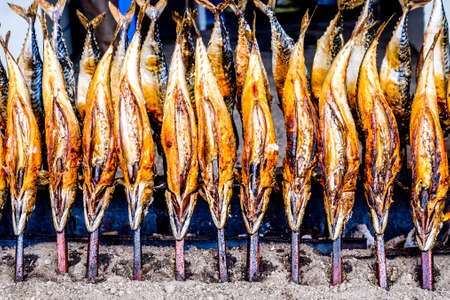Introduction to Catfishing Baits
When it comes to catfishing in the U.S., choosing the right bait can make all the difference between a slow day on the water and hauling in a cooler full of channel cats or blues. For American anglers, bait selection isn’t just about preference—it’s about matching tactics to conditions, target species, and even regional traditions. In the world of catfishing, there are two main camps: those who swear by live bait, and those who rely on prepared baits, whether store-bought or homemade. Live bait usually means using things like shad, bluegill, nightcrawlers, or minnows—anything that’s still wriggling when you put it on the hook. Prepared baits, on the other hand, cover everything from stink baits and dough baits to punch baits and dip baits that you can buy at your local tackle shop or whip up in your own kitchen. Each option has its own set of advantages and drawbacks, and understanding these differences is key to upping your game and landing more fish. This article breaks down both types of bait so you can decide what works best for your next catfishing adventure.
2. Live Bait for Catfish: Pros and Cons
When it comes to targeting catfish, live bait options like nightcrawlers, minnows, and shad are often top picks among American anglers. These baits mimic the natural prey of catfish, making them highly effective in attracting bites from both channel cats and big flatheads. Below, we’ll break down the advantages, challenges, and key local regulations associated with using live bait for catfishing.
Effectiveness of Live Bait
Live bait stands out because it triggers the predatory instincts of catfish. The scent, movement, and vibrations produced by a lively minnow or wriggling nightcrawler can draw catfish in from a distance—even in murky waters where other baits fail. This is especially true when fishing rivers or larger lakes where catfish rely on their senses to locate food.
Pros and Cons of Using Live Bait
| Benefit | Description |
|---|---|
| Natural Attraction | Live bait’s natural movements and scent increase strike rates, especially for trophy-sized cats. |
| Versatility | Works well in various water conditions—clear or muddy, warm or cold. |
| Bigger Fish Potential | Larger catfish often prefer live prey over artificial options. |
| Challenges | |
| Bait Maintenance | Keeping bait alive and active requires aerators, coolers, and frequent monitoring. |
| Cost & Availability | Live bait can be more expensive and sometimes hard to source locally. |
| Transport Restrictions | Some states prohibit transporting certain live species between bodies of water. |
Local Regulations You Need to Know
Before hitting your favorite fishing hole with a bucket of minnows, always check your state’s fishing regulations. Many U.S. states have strict rules about what species can be used as live bait to prevent the spread of invasive fish and diseases. For example, transporting live shad across county lines might be illegal in some regions. It’s also common for wildlife agencies to require proof that your bait was purchased from a certified dealer rather than wild-caught. Failing to follow these rules could result in hefty fines or confiscation of your gear.
If you’re serious about landing more—and bigger—catfish using live bait, know the benefits but also be ready for the extra work and legal homework that comes with it.
![]()
3. Prepared Baits for Catfish: Pros and Cons
Popular Prepared Baits in the U.S.
When it comes to catching catfish, prepared baits—such as stink baits, dough baits, and cheese baits—are go-to choices for many American anglers. These store-bought or homemade concoctions are designed specifically to trigger the strong sense of smell and taste that catfish rely on when hunting for food.
Stink Baits
Stink baits are notorious for their pungent odor, often made from fermented fish parts, blood, or other animal byproducts. Their overwhelming scent is a magnet for channel catfish, especially in warm waters. The biggest advantage of stink bait is its ability to attract catfish from long distances, making it ideal for murky rivers and lakes where visibility is low. However, stink baits can be messy to handle and may not be as effective in cold water when catfish are less active.
Dough Baits
Dough baits are a classic favorite among bank fishermen and families fishing from docks. They’re easy to mold onto treble hooks and can be flavored with everything from garlic to anise oil. Dough baits work well for smaller catfish species like channels and bullheads. The downside? They’re less durable than live bait and can easily be stolen by smaller fish or washed off in current-heavy waters.
Cheese Baits
Cheese-based baits use processed or natural cheese as a key ingredient, sometimes combined with other strong scents. Cheese baits excel in attracting hungry channel cats and blues, especially during summer months when water temps rise. While convenient and easy to store, cheese baits might lose effectiveness if left out too long under the sun or if used in heavily pressured waters where fish become wary.
Advantages of Prepared Baits
The top benefits of prepared baits include convenience, consistent availability, and minimal storage requirements compared to keeping live bait alive. They’re also legal in most public waters and don’t require special permits.
Limitations and Best Use Cases
On the flip side, prepared baits may not always entice larger or more cautious flathead catfish, which often prefer live prey. Prepared baits shine best when targeting eating-size channel cats in muddy or slow-moving water, during warmer seasons when scent dispersion is at its peak. For quick action on a family outing or when you want to avoid the hassle of handling live critters, prepared baits are hard to beat.
4. Regional Preferences and Traditions
When it comes to catching catfish, the choice between live bait and prepared baits often boils down to where you’re fishing in the U.S. Catfishing culture runs deep from the bayous of the South to the big rivers of the Midwest, and each region has its own time-tested preferences and methods. Understanding these traditions can help you select the best bait for your next trip and even strike up some friendly conversation with locals at the boat ramp.
Southern Catfishing: Tradition Meets Ingenuity
Down South, catfishing is as much a part of life as sweet tea and barbecue. Many Southern anglers swear by live baits—think lively shad, sunfish, or skipjack—especially when targeting big flatheads and blues in rivers and reservoirs. However, punch baits, stink baits, and even homemade concoctions passed down through generations are widely used for channel cats, especially in muddy waters or during summer months.
Midwestern Waters: Home of Prepared Baits
The Midwest is famous for its sprawling lakes and mighty rivers like the Mississippi. Here, prepared baits—dip baits, dough balls, and commercial stink baits—are extremely popular for channel catfish, largely because they’re effective, easy to use, and available at any tackle shop. Still, live bait like nightcrawlers or cut bait (pieces of shad or sucker) remains a go-to for trophy hunters chasing big blues or flatheads.
Bait Preferences by Region
| Region | Preferred Bait Type | Typical Target Species | Popular Waters |
|---|---|---|---|
| South | Live bait (shad, sunfish), homemade stink/punch baits | Flathead, Blue, Channel Catfish | Rivers (Mississippi, Tennessee), Lakes (Toledo Bend) |
| Midwest | Prepared/dip/stink baits, cut bait, nightcrawlers | Channel Catfish, Flathead Catfish | Lakes (Lake Erie), Rivers (Ohio River) |
| Northeast/West Coast | Cut bait, worms, commercial prepared baits | Channel Catfish | Lakes (Clear Lake CA), Rivers (Hudson River NY) |
Cultural Influences on Bait Choice
Bait selection isn’t just about what works—it’s also about family tradition and local know-how. In many regions, recipes for homemade baits are closely guarded secrets. Some anglers in the Ozarks mix up their own batch of cheese-based dip bait every spring; others along the Red River won’t fish without fresh-caught goldeye as cut bait. Local regulations may also play a role: certain waterways restrict live bait use to prevent spreading invasive species.
No matter where you cast your line in America, knowing what’s popular—and why—in your region can give you an edge when hunting for whiskered giants. Whether you lean toward lively bluegill or a smelly jar of dip bait depends not only on what the catfish are biting but also on the rich patchwork of U.S. catfishing culture.
5. Best Practices for Selecting and Using Catfish Bait
Choosing Between Live and Prepared Baits
Selecting the right bait for catfishing depends on a few key factors: water conditions, target catfish species, and your personal fishing style. Live baits, such as nightcrawlers, shad, or bluegill, are ideal when targeting flathead and channel catfish in rivers or lakes with plenty of natural forage. Prepared baits like stink baits, dough balls, or chicken liver are popular for their convenience and potent scent trails, especially effective for channel cats in muddy or slow-moving waters where visibility is low.
Bait Presentation Techniques
Presentation can make or break your success rate. When using live bait, hook placement is critical; a lively baitfish should be hooked through the lips or back to keep it active and enticing. For prepared baits, use treble hooks and bait holders designed to keep soft or sticky bait secure during long casts. Let the scent disperse naturally by casting upstream if you’re in a river, so the current delivers that aroma right to waiting catfish.
Matching Bait to Water Conditions
Clear water generally favors more natural presentations—think live bait with subtle movement. In stained or muddy water, opt for prepared baits with strong odors to help catfish home in on your line. After heavy rain, runoff brings food into the system; try live worms or cut bait for best results.
Targeting Specific Catfish Species
Flathead catfish prefer live prey, so offer them fresh bluegill or goldfish where legal. Channel cats are less picky but love stink baits and punch baits packed with cheese or blood meal. Blue catfish respond well to cut shad or skipjack—choose larger chunks for trophy fish and smaller pieces for eaters.
Maximizing Your Success
Regardless of bait choice, always keep your gear sharp: use strong hooks, check your knots frequently, and adjust weight according to current speed. Move locations if you haven’t had a bite within 30–45 minutes; sometimes just a slight change in depth or cover makes all the difference. Stay flexible—sometimes switching from live to prepared bait (or vice versa) can turn a slow day into a productive one.
6. Ethics and Conservation
When it comes to catfishing, being a responsible angler means thinking beyond just catching fish. Whether you prefer live bait or prepared baits, ethical considerations and conservation practices should always be part of your game plan. Using live bait—such as minnows, shad, or nightcrawlers—can sometimes introduce invasive species if those baitfish are not local to the water youre fishing. Always source your live bait from reputable suppliers who follow local regulations, or better yet, collect bait from the same body of water you’ll be fishing in. This helps prevent accidental introduction of non-native species that could disrupt local ecosystems.
Prepared baits—like dough balls, stink baits, or commercial pellets—carry less risk of spreading invasives, but they still require thoughtful use. Avoid dumping unused bait into the water or shoreline to minimize negative environmental impact. Remember, even organic materials can alter the nutrient balance in lakes and rivers.
Practicing catch-and-release with care is another cornerstone of conservation-minded catfishing. Use circle hooks when possible to reduce deep hooking, and handle catfish gently to avoid injury before returning them to the water. Stay up-to-date on local regulations regarding bait types, bag limits, and protected areas; these rules are designed to maintain healthy fish populations for future generations.
Ultimately, whether youre casting live bluegill or rolling homemade stink bait, being an ethical angler means respecting both the fish and their habitat. Make smart choices about your bait and your actions on the water—you’ll help preserve America’s great catfishing tradition for years to come.
7. Conclusion and Final Recommendations
Choosing between live bait and prepared baits for catfishing boils down to your fishing goals, local regulations, and personal preferences. Live bait like shad or nightcrawlers often delivers the most natural presentation and can trigger aggressive strikes from larger catfish, especially in rivers and lakes with abundant forage. However, live bait requires more care, handling, and sometimes special storage equipment. Prepared baits such as dough balls, stink baits, and punch baits are convenient, mess-free, and great for attracting channel cats or when you’re introducing beginners or kids to catfishing.
Best Practices for Smart Bait Selection
Know Your Water
Always research the local water conditions and catfish species present. Some waters have bait restrictions to protect native species or prevent invasive introductions. Check state regulations before using any live bait.
Match the Hatch
If you’re after big flatheads or blues, using native live bait is often your best bet. For channel cats or when targeting numbers rather than size, prepared baits can be just as effective—especially in heavily fished areas where scent matters most.
Sustainability Matters
Be mindful of the environment: don’t release unused live bait into new waters, always dispose of packaging responsibly, and consider catch-and-release practices when appropriate to maintain healthy fisheries for future generations.
Final Advice
Experiment with both types of bait to see what works best in your favorite fishing spots. Bring a variety—sometimes conditions change quickly and flexibility pays off. Most importantly, enjoy the process! Whether you prefer the challenge of keeping minnows lively or the simplicity of scooping out a glob of stink bait, making informed decisions helps ensure every trip is rewarding and sustainable.


